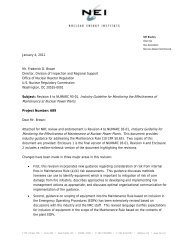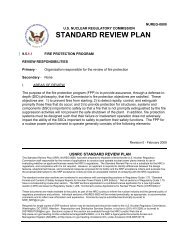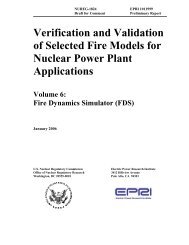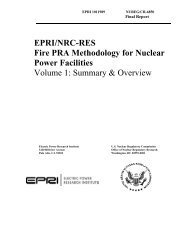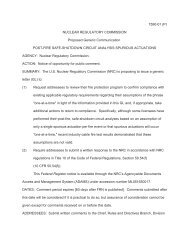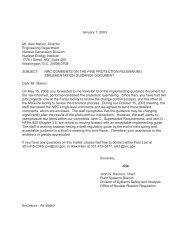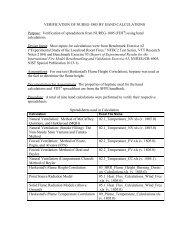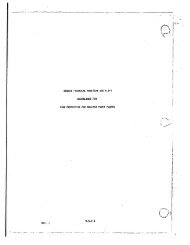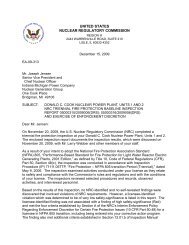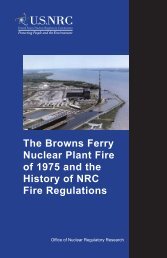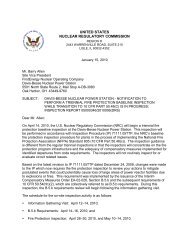NRC Slides for NEIFPIF Robert Vettori New Reactor Fire Protection ...
NRC Slides for NEIFPIF Robert Vettori New Reactor Fire Protection ...
NRC Slides for NEIFPIF Robert Vettori New Reactor Fire Protection ...
You also want an ePaper? Increase the reach of your titles
YUMPU automatically turns print PDFs into web optimized ePapers that Google loves.
<strong>New</strong> <strong>Reactor</strong> <strong>Fire</strong> <strong>Protection</strong><br />
Programs<br />
<strong>Robert</strong> <strong>Vettori</strong><br />
<strong>Fire</strong> <strong>Protection</strong> Team<br />
Division of Safety Systems and Risk<br />
Assessment<br />
Office of <strong>New</strong> <strong>Reactor</strong>s<br />
<strong>Fire</strong> <strong>Protection</strong> In<strong>for</strong>mation Forum<br />
Savannah, GA - September 2009
Presentation Summary<br />
• Regulatory requirements and guidance <strong>for</strong> new<br />
reactor fire protection programs<br />
• Current status of fire protection program reviews<br />
• NFPA 804 application to new reactors<br />
• NFPA 806 application to new reactors<br />
• Multiple spurious actuations<br />
• <strong>Fire</strong> PRA requirements<br />
• Aircraft impact assessment and large fire<br />
response<br />
2
Regulatory Requirements and<br />
Guidance<br />
• Current fire regulations, including 10 CFR<br />
50.48(a) and GDC 3, will apply<br />
• Criteria <strong>for</strong> enhanced fire protection<br />
provided in SECYs-93-087 and 90-016<br />
• SRP 9.5.1 and RG 1.189189 have been<br />
revised to include guidance <strong>for</strong> new<br />
reactor FPPs<br />
• COL application guidance in RG 1.206<br />
3
Enhanced <strong>Fire</strong> <strong>Protection</strong><br />
• Applicable to all new reactors<br />
• Ensure safe shutdown assuming all equipment<br />
in any one fire area (excluding control room and<br />
containment) will be rendered inoperable by fire<br />
and that re-entry entry is not possible <strong>for</strong> mitigation<br />
• Ensure that smoke, hot gases, or the fire<br />
suppressant will not migrate into other fire areas<br />
to the extent that safe shutdown could be<br />
adversely affected<br />
4
Current Status of FPP Reviews<br />
• Standard Designs have been certified by<br />
the <strong>NRC</strong> <strong>for</strong><br />
• ABWR and AP1000<br />
• Standard Designs in review<br />
ESBWR, EPR, US-APWR and the<br />
AP1000-amendment<br />
5
Current Status of FPP Reviews<br />
RCOL applications<br />
ABWR (South Texas)<br />
AP1000 (Vogtle)<br />
SCOL applications<br />
Bell Bend<br />
Bellefonte<br />
Callaway<br />
Comanche Peak<br />
Fermi<br />
Grand Gulf<br />
Levy County<br />
ESBWR (North Anna)<br />
EPR (Calvert Cliffs)<br />
Nine Mile Point<br />
River Bend<br />
Shearon Harris<br />
Turkey Point<br />
Virgil Summer<br />
William States Lee<br />
2 Additional Applications are expected<br />
6
Review Highlights<br />
• In general, fire protection programs comply with<br />
regulatory requirements and guidance, including<br />
enhanced fire protection features per SECYs.<br />
• Most vendors are taking exception to MCR protection –<br />
staff has accepted based on final fire hazards analysis<br />
and control procedures.<br />
• Vendors are addressing multiple l spurious actuations ti in<br />
accordance with staff expectations.<br />
• Virtually no crediting of operator manual actions and<br />
minimal electrical raceway fire barrier systems.<br />
• Smoke affects on digital equipment still needs to be<br />
evaluated by staff and industry<br />
7
NFPA 804 – Standard <strong>for</strong> ALWRs<br />
• Provides acceptable guidance when used in conjunction<br />
with <strong>NRC</strong> regulations and guidance – not <strong>for</strong>mally<br />
endorsed by <strong>NRC</strong><br />
• Deterministic approach to FPP<br />
• Does not fully con<strong>for</strong>m with the criteria <strong>for</strong> enhanced fire<br />
protection<br />
• Committee has agreed to delete requirement <strong>for</strong> one-ata-time<br />
approach to MSAs<br />
• Referenced by AP1000, ESBWR, US-APWR, and EPR<br />
• Referenced by COLAs <strong>for</strong> site specific fire protection<br />
8
NFPA 806 Per<strong>for</strong>mance-Based FPP<br />
• Committee agreed to revise scope to only<br />
address the plant change process<br />
• Change process is similar to the NFPA 805<br />
process<br />
• No applicants have proposed a per<strong>for</strong>mance-<br />
based approach to plant changes yet<br />
• First issuance scheduled <strong>for</strong> 2010 – license<br />
holders would likely need license amendment to<br />
adopt.<br />
• Staff will consider endorsing the standard<br />
9
Multiple Spurious Actuations<br />
• Staff position is that a one-at-a-time approach<br />
may not adequately address the potential risk<br />
due to fire<br />
• Staff position <strong>for</strong> addressing multiple spurious<br />
actuations ti <strong>for</strong> new reactors will likely l be<br />
consistent to that <strong>for</strong> existing reactors<br />
• Train separation by barriers and use of fiber<br />
optic cables should minimize spurious<br />
actuations <strong>for</strong> new reactors<br />
10
Multiple Spurious Actuations and Digital I&C<br />
Systems<br />
• Generally assumed that fiber optic cables are<br />
not susceptible to hot shorts<br />
• Effects of heat and smoke on digital equipment<br />
have not been well established<br />
• Further testing may be needed<br />
• Staff encourages industry to demonstrate<br />
viability of assumptions made with respect to fire<br />
effects on digital cabling and equipment<br />
11
<strong>Fire</strong> PRA Requirements<br />
• 10 CFR 50.71(h)(1) requires new reactor license holders<br />
to develop a Level 1 and Level 2 fire PRA - once a<br />
standard is issued and endorsed by the <strong>NRC</strong><br />
• Until endorsement, COL applicants can use the<br />
methods described in the applicable certified design <strong>for</strong><br />
addressing fire risks<br />
12
Aircraft Impact – <strong>New</strong> <strong>Reactor</strong>s<br />
• Aircraft Impact Assessment (AIA) Rule became<br />
effective July 13, 2009<br />
• Draft Regulatory Guide (DG-1176) endorsing<br />
NEI 07-13, “Methodology <strong>for</strong> Per<strong>for</strong>ming Aircraft<br />
Impact Assessments <strong>for</strong> <strong>New</strong> Plant Designs”<br />
was issued <strong>for</strong> public comment on July 10, 2009<br />
• Developing <strong>for</strong>mat and content guidance <strong>for</strong> AIA<br />
input to FSAR Chapter 19<br />
• Future SRP section is planned<br />
13
Loss of Large Areas<br />
• Rule 50.54 (hh)(2) would require plants to<br />
develop guidance and mitigation strategies to<br />
address loss of large areas of the plant due to<br />
explosions or fires from a beyond-design basis<br />
event<br />
• NEI 06-12 Rev. 3 includes “B.5.b Phase 2&3<br />
Submittal Guideline” has been revised to include<br />
new reactors<br />
• FPP (Phase 1) aspect primarily the fire fighting<br />
response strategies via MST tables<br />
14
Summary<br />
• Current regulations and guidance, with enhancements, are<br />
applicable to new reactor FPPs<br />
• NFPA 804 is the standard of choice <strong>for</strong> most designs to date<br />
– but does not fully meet staff expectations<br />
• NFPA 806 will provide option <strong>for</strong> per<strong>for</strong>mance-based<br />
approach to plant change evaluation<br />
• Multiple spurious guidance will likely follow resolution <strong>for</strong><br />
existing plants<br />
• <strong>Fire</strong> effects on digital I&C components may need further<br />
study<br />
• <strong>Fire</strong> PRA which meet fire PRA Standard will be required <strong>for</strong><br />
new reactor plants<br />
• Aircraft impact assessment includes postulated fire damage<br />
• <strong>Fire</strong> fighting strategies will be required <strong>for</strong> explosions and<br />
large fires<br />
15





